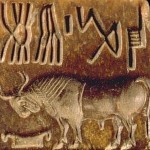 We have all kinds of artifacts engraved with the hieroglyphic script of the Indus Valley civilization, but so far nobody has been able to decipher the language.
We have all kinds of artifacts engraved with the hieroglyphic script of the Indus Valley civilization, but so far nobody has been able to decipher the language.
Researchers from the University of Washington and the Institute of Fundamental Research and Centre for Excellence in Basic Sciences in Mumbai are using computers to find patterns in the placement and order of the hieroglyphics. The patterns can then be extrapolated into a statistical model that reveal the grammatical underpinnings of the language.
“The statistical model provides insights into the underlying grammatical structure of the Indus script,” said lead author Rajesh Rao, a UW associate professor of computer science. “Such a model can be valuable for decipherment, because any meaning ascribed to a symbol must make sense in the context of other symbols that precede or follow it.”
The new study looks for mathematical patterns in the sequence of symbols. Calculations show that the order of symbols is meaningful; taking one symbol from a sequence found on an artifact and changing its position produces a new sequence that has a much lower probability of belonging to the hypothetical language. The authors said the presence of such distinct rules for sequencing symbols provides further support for the group’s previous findings, reported earlier this year in the journal Science, that the unknown script might represent a language.
“These results give us confidence that there is a clear underlying logic in Indus writing,” Vahia said.
The examples of the script we have are just 5 or 6 symbols long, so there’s been some question as to whether it’s a language system at all. The fact that researchers have found syntactical patterns indicates that it is indeed a language and not just a collection of religious or political pictograms.